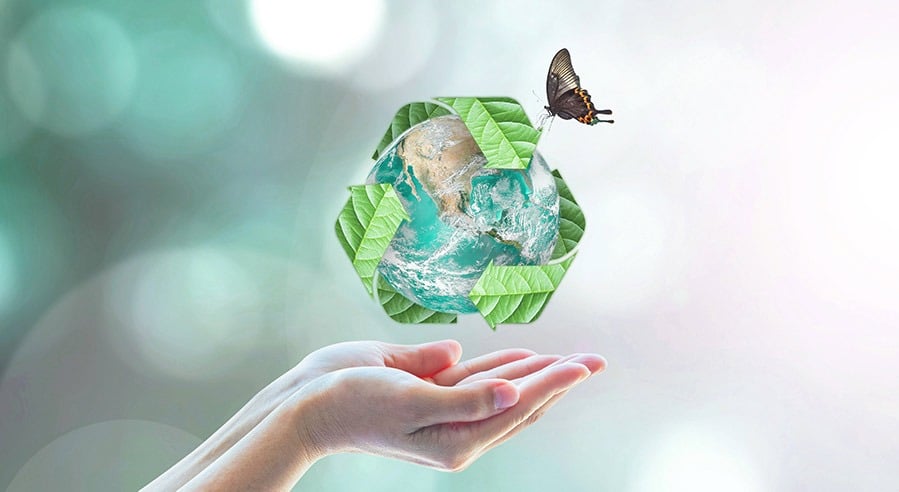
Every aspect of our lives is going green right now. This has resulted in a new wave of eco-friendly terminologies to help consumers identify “green” products and make better consumer decisions.
The most common of these terms include PLA, CPLA, bamboo, bagasse, sustainable paper/wood, recycled steel, recyclable, reusable, biodegradable, compostable, carbon footprint, carbon-neutral, eco-conscious, eco-friendly, and greenhouse gas.
This guide will help you to better understand the eco-friendly terminology now being used. Hopefully, it will serve as a guide to inform you, the consumer, to make better eco-conscious choices.
Why Eco-Friendly Terminology?
It’s imperative that new products clearly identify why they’re eco-friendly. It’s important to avoid confusing consumers. Knowing what the terminology means can help people make the right choices.
Walk into any store right now, and the number of eco-friendly labels adorned on products is overwhelming. You should learn what each term means so you can be sure you’re buying exactly what you think you’re buying.
Unfortunately, not all brands use terminology correctly. This builds distrust between the consumer and the brands. Knowing what each term means can help us to buy from the right brands and buy the best eco-friendly products.
The Complete Guide to Eco-Friendly Terms
To make this easier, we have broken the eco-friendly terms down into sections. With so many different products, materials, and features used, this is necessary.
Eco-Friendly Materials Terminology
Eco-friendly materials are a hot trend right now. With the rise of eco-conscious consumerism and veganism, more companies than ever are looking to alternative eco-friendly materials for their products.
Bagasse
Bagasse is derived from recycled sugarcane and is an extremely useful alternative to polystyrene. Bagasse is exceptionally eco-friendly as it is made from a renewable resource that is otherwise a waste product from the sugar industry.
Bagasse is 100% compostable and has become popular for use in the takeaway industry. Bagasse naturally allows condensation to escape while retaining heat inside the container. Great for pizza!
Bamboo Fiber
Bamboo is an ultra-strong and natural fast-growing plant from Asia. It’s an incredible natural antimicrobial, hypoallergenic, and moisture-wicking properties that have made it a popular eco-material over the last few years.
It is mostly used for zero-waste products such as straws, cups, and dishware. You can also buy bamboo sheets, bamboo curtains, and even bamboo clothes.
Bamboo Hardwood
When compared to other hardwoods used in the construction industry, bamboo is a much more sustainable alternative due to the speed at which the bamboo plant grows. Trees like pine, oak, maple, and hickory take up to 25 years to reach harvest maturity. Bamboo takes just five.
Most bamboo is grown and manufactured in China. This helps to reduce the carbon footprint on bamboo. Other hardwoods are felled in Europe, shipped to China for manufacturing, and then sent back, creating a huge carbon footprint. Always ensure your bamboo is FSC certified.
Bioplastic Compostables
Sugar cane fibers are used to create innovative new plastics that are completely biodegradable and contain no harsh chemicals. Traditional plastic can take hundreds of years to decompose, bioplastic takes just 3 to 6 months and does not leach chemicals.
Some of the biggest companies in the world are switching to bioplastic to help mitigate their impact on the planet. Plastic pollution has a severe impact on our planet. Bioplastics feel and work just like regular plastics making them an integral part of the solution.
Cork
Many of us use cork all the time when popping open a bottle of wine or champagne. But cork has far more potential than we think. Cork is naturally light, buoyant, and waterproof. The entire cork tree is not needed to harvest cork either, just the bark is taken.
Cork trees can live up to 300 years old making cork, as material, incredibly sustainable. What; ‘s more, when the bark of a cork tree is taken, the tree actually absorbs more CO2 from the atmosphere. It is, therefore, beneficial to both cork trees and us to harvest their bark regularly. It is also completely biodegradable and recyclable.
Eco-conscious companies have been able to use cork for flooring, wall coverings, fashion textiles, alternative leather, and plastics.
CPLA
CPLA is a similar form of PLA but has been crystallized. This gives it extra strength and superior heat resistance. You will notice that PLA is used for cold use and CPLA for hot use, mostly in the food and drinks industry.
Hemp
Hemp has become increasingly popular as eco-materials ever since world governments relaxed laws surrounding its use. Hemp is often confused with the marijuana plant due to their similar looks.
Hemp can grow free of pesticides and fertilizers, yielding more than 250% more fiber than cotton, and uses 50% less water to be turned into usable fabric. Hemp is, therefore, a highly sustainable alternative to traditional cotton.
Hemp is now mostly used for clothing and other fabric goods like bedsheets and blankets. Hemp seed oil has also proven to be useful in the food industry. Hemp oil can now be found in all sorts of food products, including protein powders, chocolate, and even milk.
Palm Leaf
Palm leaves naturally shed from palm trees several times a year. Some eco-brands are now using palm leaves to create eco-packaging and decorative bowls and plates. Each palm leaf is entirely unique in its color and patterns making these products extra special.
Palm leaves are entirely organic, biodegradable, renewable, and free from any toxic chemicals. This makes palm leaves an excellent alternative to polystyrene packaging for the food industry.
Pinatex
Pinatex is an innovative new material made from pineapple leaf fiber. The leaves are a by-product of the pineapple industry. This means now specific farming is required to grow the materials, and the pineapple farmers get an increase in income.
Pinatex is an entirely natural, sustainable, cruelty-free, and 100% biodegradable material. It is currently being used to create shoes, handbags, and purses.
PLA
PLA (or polylactic acid) is a new type of plastic that is compostable. This means it will naturally decompose if left in the earth. Unlike traditional plastic that takes up to 500 years to decompose, PLA will decompose in 45-90 days.
PLA can be made of various plant materials but is most commonly produced using cornstarch. PLA works and feels just like regular plastic. This has led to it being used by many companies for packaging and disposable products.
Sustainable Paper or Wood
You may see the terms and accreditations for durable paper and wood often. They both provided a fantastic solution to our needs for each material. Chopping down trees is, of course, an environmentally unfriendly process.
However, if the forest is managed sustainably, there are considerable advantages to the environment and the local people. You may see the logo for “FSC” on these products. This way, you can be sure the product has come from an ethical resource.
Recycled Glass
It’s imperative that you always recycle your glass bottles and jars. Glass can quickly be melted down and recycled for new purposes. Recycled glass is produced using lower temperatures than new glass, which helps to improve its carbon footprint.
When you recycle glass, it helps to avoid going to landfills, putting further strain on waste management services and our planet. Glass can also be upcycled for new uses in your home and garden. All glass bottles and jars sold are recyclable.
Recycled Steel
Steel is a resource-intensive material that is far from friendly to our planet. However, steel is highly durable and recyclable. There are millions of metric tonnes of steel waiting to be recycled and repurposed.
When you consider the long life of steel products, recycled steel can be regarded as more eco-friendly than other eco-materials on this list. For example, a recycled steel eco-straw will outlive a bamboo straw up to five times longer.
Teak
Teak is a special hardwood from Southeast Asia that has proven to be a sustainable material for wooden furniture and decking. The natural oils found within the tight grains of teak make the wood naturally weather-resistant. This makes the wood resistant to dry rotting and parasites.
Teak is a well-managed material from Indonesia in which the government sets limitations on the number of trees that can be felled each year. It is current law that for every tree that falls, another is planted. These are strict regulations.
Teak is naturally durable and looks stunning. All the factors mentioned above have resulted in teak being slapped with a heavy price tag. However, the ROI is worth it if you consider how much time and money you would usually spend on annual waterproofing for other hardwoods.
End-of-Life Terminology
What happens to products after we have finished with them can be just as important as how they were produced. Waste is a serious environmental issue that negatively affects our land, water, air, wildlife, and humans.
Biodegradable
A product labeled as biodegradable means when it is left on the ground, it will naturally decompose back into the soil. These products are usually made with 100% natural materials such as bamboo or hemp.
Many non-biodegradable materials such as plastic take hundreds of years to decompose and leak toxic chemicals into the ground. These chemicals then affect the natural environment polluting the soil, water, air, and local wildlife.
Compostable
Composting is a trend that has recently taken off around the world in people’s gardens. This is the act of purposely creating an environment in which certain materials can decompose to create nutrient-rich compost. This compost can then be used in the garden to promote healthy soil and plant growth.
You can compost all your waste food at home by merely throwing it into your composter. Some products now carry a “compostable” label. This means they have met specific standards and are certified safe to compost.
Composting takes the strain off our waste management systems and allows us to grow healthier gardens at home.
Recyclable
When a product is labeled as recyclable, it merely means the raw materials can be reused for a new product. The most common recyclable materials include:
- Paper
- Cardboard
- Some metals
- Some plastics
- Glass
Recycling has a positive effect on our planet, helping us to reduce the need to dig out, chop down, or create more raw materials from our earth. Recycling helps to reduce the vast amounts of waste heading to our landfills also.
Reusable
Reusable simply means the product or material can be reused again or repurposed. Reusable products last for years before needing to throw them out.
Reusable items have sparked the recent “zero-waste” trend. Zero-waste products are intended to be bought and used for years to help eliminate the number of disposable items we use. Many of these reusable products can be recycled once finished with.
General Eco-Friendly Terminology
As well as specific terminology for materials and end-of-life, there are general terms for eco-friendly living.
Alternative Energy
Alternative energy usually refers to an energy source that is not produced by fossil fuels. This could include renewable energy sources such as solar, wind power, hydro, or biomass.
Antimicrobial
Some eco-materials, such as bamboo fibers, have natural antimicrobial properties. This means that the material will naturally prevent microbial growth, mold, odors, and stains. Some synthetic materials can also be antimicrobial using natural chemical additives.
Biomass
Biomass is wood-based materials, agricultural crops, animal waste, and other organic waste that, when burnt, can be used as a source of energy. Biomass boilers have become increasingly popular over the last decade as an alternative to gas boilers.
Biomass materials are considered a renewable source of energy because they only emit the CO2 that was once naturally absorbed when alive, such as trees.
Carbon Footprint
The carbon footprint of a product or service is an estimation of how much CO2 was produced or used as a result of said product or service. This will usually include everything from the way the materials were produced to transport and packaging.
The lower the carbon footprint, the better for the environment.
Carbon Neutral
Many new products on the market come with a “carbon neutral” label. This simply means that when you use the product, it will only emit as much carbon dioxide as the material has taken out of the atmosphere in its raw form.
For example, a tree grows by taking carbon dioxide out of the air and producing oxygen. When you burn its wood, it only releases the same amount of carbon dioxide as it took in, back into the air. This makes wood carbon neutral.
Carbon neutral can also be used to describe a company or service. This means that they have taken a specific action, such as planting trees, to offset the carbon dioxide produced by their company, products, or services.
Carbon Offsetting
Some eco-conscious companies claim to offset the carbon emissions that are emitted during the production of their goods or use of their services. To offset their carbon emissions, they fund specific projects that reduce greenhouse gas emissions, such as planting trees.
Carbon offsetting has become a popular service offered in the airline industry when purchasing flight tickets. The airline will calculate your personal footprint for the flight and then plant as many trees as required to offset that number. You have to pay for this service, and it can be expensive.
Climate Change
Climate change has become the standard term used to discuss global warming. Global warming occurs when excessive gases get trapped within our atmosphere, which then heats up the planet’s average temperature.
Climate change, if not acted on accordingly, will result in adverse weather and rising sea levels in the future. Many of these effects are already being observed in some parts of the world.
Eco-Conscious
To be eco-conscious means to actively think and act with the best intentions for the environment. This will affect your way of living, the products you buy, what you eat, how you dispose of waste, and even what companies you support.
Eco-conscious people are always striving to minimize their negative impact on the planet as much as possible and where practicable.
Eco-Friendly and Environmentally Friendly
Eco-friendly and environmentally friendly are two terms that describe a product, service, system, practice, or process. If something is eco-friendly or environmentally friendly, then it has it’s negative impact on the planet in some way.
Ecosystem
An ecosystem is a term to describe the interaction of organisms with each other and their environment set in a natural community. For example, a rainforest is a complex and vital ecosystem.
Energy-Efficient
Used to describe products and services in regards to how much energy they use to be produced or operate. The more energy-efficient a product or service is, the better for the environment.
Energy-Star
Energy-star is an international standard for energy-efficient consumer goods and appliances. Products or devices that carry the energy-star logo generally use 20-30% less energy, which saves you money on your bills and reduces your impact on the planet.
Greenhouse Gas
A greenhouse gas is a harmful gas that gets trapped inside the earth’s atmosphere. This is called the “greenhouse effect.” As toxic gases try to escape our atmosphere, they are rebounded back towards the planet, which increases the average global temperatures.
We could not survive without greenhouse gases as the earth would become too cold. However, as pollution continues to grow, we now have too many greenhouse gases trapped within our atmosphere. This is radically warming the average temperature of the earth. This is known as “global warming.”
The most common greenhouse gases include carbon dioxide, methane, water vapor, and nitrous oxide.
Green Washing
A term used to describe companies that spin their products or services as being eco-friendly but with a little investigation does not meet the right criteria to rightfully do so. This is a dishonest act to help sell their product or service to eco-conscious consumers.
Life Cycle
Used to describe the entire life of a product from its raw material to manufacturing to purchasing to use and finally disposal. Life-cycle assessments help us to see the impact of a product on the planet during its entire life.
Organic
A term used for foods and natural raw materials that are grown without the use of artificial pesticides and fertilizers. Organic foods are considered to be better for the environment and your health.
Final Thoughts
Eco-friendly terms are useful for helping eco-conscious consumers to decide on which company, product, or service they want to use.
If you want to make better choices that positively impact the planet, make sure you look out for these terms when next shopping or considering using a new service.



